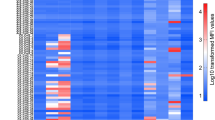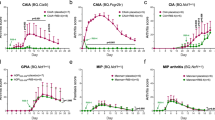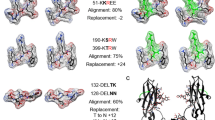Abstract
Arthritis in the K/BxN mouse model results from pathogenic immunoglobulins (Igs) that recognize the ubiquitous cytoplasmic enzyme glucose-6-phosphate isomerase (GPI). But how is a joint-specific disease of autoimmune and inflammatory nature induced by systemic self-reactivity? No unusual amounts or sequence, splice or modification variants of GPI expression were found in joints. Instead, immunohistological examination revealed the accumulation of extracellular GPI on the lining of the normal articular cavity, most visibly along the cartilage surface. In arthritic mice, these GPI deposits were amplified and localized with IgG and C3 complement. Similar deposits were found in human arthritic joints. We propose that GPI–anti-GPI complexes on articular surfaces initiate an inflammatory cascade via the alternative complement pathway, which is unbridled because the cartilage surface lacks the usual cellular inhibitors. This may constitute a generic scenario of arthritogenesis, in which extra-articular proteins coat the cartilage or joint extracellular matrix.
This is a preview of subscription content, access via your institution
Access options
Subscribe to this journal
Receive 12 print issues and online access
$209.00 per year
only $17.42 per issue
Buy this article
- Purchase on Springer Link
- Instant access to full article PDF
Prices may be subject to local taxes which are calculated during checkout





Similar content being viewed by others

References
Lanchbury, J. S. & Pitzalis, C. Cellular immune mechanisms in rheumatoid arthritis and other inflammatory arthritides. Curr. Biol. 5, 918–924 (1993).
Kouskoff, V. et al. Organ-specific disease provoked by systemic autoreactivity. Cell 87, 811–822 (1996).
Korganow, A.-S. et al. From systemic T cell self-reactivity to organ-specific autoimmune disease via immunoglobulins. Immunity 10, 451–461 (1999).
Matsumoto, I., Staub, A., Benoist, C. & Mathis, D. Arthritis provoked by linked T and B cell recognition a glycolytic enzyme. Science 286, 1732–1735 (1999).
Basu, D., Horvath, S., Matsumoto, I., Fremont, D. H. & Allen, P. M. Molecular basis for recognition of an arthritic peptide and a foreign epitope on distinct MHC molecules by a single TCR. J. Immunol. 164, 5788–5796 (2000).
Maccioni, M. et al. Arthritogenic monoclonal antibodies from K/BxN mice. J. Exp. Med. (in the press, 2002).
Ji, H. et al. Arthritis critically dependent on innate immune system players. Immunity 16, 157–168 (2002).
West, J. D., Flockhart, J. H., Peters, J. & Ball, S. T. Death of mouse embryos that lack a functional gene for glucose phosphate isomerase. Genet. Res. 56, 223–236 (1990).
Frohman, M. A., Dush, M. K. & Martin, G. R. Rapid production of full-length cDNAs from rare transcripts: amplification using a single gene–specific oligonucleotide primer. Proc. Natl Acad. Sci. USA 85, 8998–9002 (1988).
Schaller, M., Burton, D. R. & Ditzel, H. J. Autoantibodies to GPI in rheumatoid arthritis: linkage between animal model and human disease. Nature Immunol. 2, 746–753 (2001).
Ishikawa, H., Smiley, J. D. & Ziff, M. Electron microscopic demonstration of immunoglobulin deposition in rheumatoid cartilage. Arthritis Rheum. 18, 563–576 (1975).
Cooke, T. D., Hurd, E. R., Jasin, H. E., Bienenstock, J. & Ziff, M. Identification of immunoglobulins and complement in rheumatoid articular collagenous tissues. Arthritis Rheum. 18, 541–551 (1975).
Vetto, A. A., Mannik, M., Zatarain-Rios, E. & Wener, M. H. Immune deposits in articular cartilage of patients with rheumatoid arthritis have a granular pattern not seen in osteoarthritis. Rheumatol. Int. 10, 13–19 (1990).
Pangburn, M. K. in The Complement System (eds Rother, K., Till, G. O. & Hansch, G. M.) 93–115 (Springer-Verlag Berlin, Heidelberg, 1998).
Vivanco, F., Munoz, E., Vidarte, L. & Pastor, C. The covalent interaction of C3 with IgG immune complexes. Mol. Immunol. 36, 843–852 (1999).
Shohet, J. M., Pemberton, P. & Carroll, M. C. Identification of a major binding site for complement C3 on the IgG1 heavy chain. J. Biol. Chem. 268, 5866–5871 (1993).
Fries, L. F., Gaither, T. A., Hammer, C. H. & Frank, M. M. C3b covalently bound to IgG demonstrates a reduced rate of inactivation by factors H and I. J. Exp. Med. 160, 1640–1655 (1984).
Jelezarova, E., Vogt, A. & Lutz, H. U. Interaction of C3b2-IgG complexes with complement proteins properdin, factor B and factor H: implications for amplification. Biochem. J. 349, 217–223 (2000).
Schwaeble, W. J. & Reid, K. B. M. Does properdin crosslink the cellular and the humoral immune response? Immunol. Today 20, 17–21 (1999).
Fearon, D. T. Regulation by membrane sialic acid of β1H-dependent decay-dissociation of amplification C3 convertase of the alternative complement pathway. Proc. Natl Acad. Sci. USA 75, 1971–1975 (1978).
Meri, S. & Pangburn, M. K. Discrimination between activators and nonactivators of the alternative pathway of complement: regulation via a sialic acid/polyanion binding site on factor H. Proc. Natl Acad. Sci. USA 87, 3982–3986 (1990).
Takahashi, S. et al. Cloning and cDNA sequence analysis of nephritogenic monoclonal antibodies derived from an MRL/lpr lupus mouse. Mol. Immunol. 30, 177–182 (1993).
Gonzalez, M. L. & Waxman, F. J. Glomerular deposition of immune complexes made with IgG2a monoclonal antibodies. J. Immunol. 164, 1071–1077 (2000).
Watanabe, H. et al. Modulation of Renal Disease in MRL/lpr Mice Genetically Deficient in the Alternative Complement Pathway Factor B. J. Immunol. 164, 786–794 (2000).
Watanabe, H. et al. Purification of human tumor cell autocrine motility factor and molecular cloning of its receptor. J. Biol. Chem. 266, 13442–13448 (1991).
Jeffery, C. J., Bahnson, B. J., Chien, W., Ringe, D. & Petsko, G. A. Crystal structure of rabbit phosphoglucose isomerase, a glycolitic enzyme that moonlights as neuroleukin, autocrine motility factor and differentiation mediator. Biochemistry 39, 955–964 (2000).
Sun, Y. J. et al. The crystal structure of a multifunctional protein: phosphoglucose isomerase/autocrine motility factor/neuroleukin. Proc. Natl Acad. Sci. USA 96, 5412–5417 (1999).
Wipke, B. T., Wang, Z., Kim, J., McCarthy, T. J. & Allen, P. M. Dynamic visualization of a joint-specific autoimmune response through positron emission topography. Nature Immunol. 3, 368–374 (2002).
Zvaifler, N. J. The immunopathology of joint inflammation in rheumatoid arthritis. Adv. Immunol. 265, 265–336 (1973).
Jasin, H. E. Immune mediated cartilage destruction. Scand. J. Immunol. 76, 111–116 (1988).
Auffray, C. & Rougeon, F. Purification of mouse immunoglobulin heavy-chain messenger RNAs from total myeloma tumor RNA. Eur. J. Biochem. 107, 303–314 (1980).
Ji, H. et al. Genetic influences on the end-stage effector phase of arthritis. J. Exp. Med. 194, 321–330 (2001).
Acknowledgements
We thank J. L. Pasquali for enlightening discussions; J. Hergueux, S. Johnson and Q. M. Pham for managing the KRN colony; C. Cahill for help with confocal microscopy; P. Gerber for ELISAs and chromatography; and D. Bowman and A. Calderone for sections. Supported by institutional funds from the INSERM, CNRS and the Centre Hospitalo-Universitaire and by grants from the Association pour la Recherche contre la Polyarthrite and the NIH (1R01 AR/AI46580-01, to D. M. and C. B), the Arthritis Foundation (I. M.), the Fondation pour la Recherche Medicale and CONICET (M. M.) and the Howard Hughes Medical Institute (D. L.).
Author information
Authors and Affiliations
Corresponding authors
Ethics declarations
Competing interests
The authors declare no competing financial interests.
Rights and permissions
About this article
Cite this article
Matsumoto, I., Maccioni, M., Lee, D. et al. How antibodies to a ubiquitous cytoplasmic enzyme may provoke joint-specific autoimmune disease. Nat Immunol 3, 360–365 (2002). https://doi.org/10.1038/ni772
Received:
Accepted:
Published:
Issue Date:
DOI: https://doi.org/10.1038/ni772
This article is cited by
-
Rheumatoid arthritis sera antibodies to citrullinated collagen type II bind to joint cartilage
Arthritis Research & Therapy (2022)
-
TIARP attenuates autoantibody-mediated arthritis via the suppression of neutrophil migration by reducing CXCL2/CXCR2 and IL-6 expression
Scientific Reports (2016)
-
Inflammatory Cell Migration in Rheumatoid Arthritis: A Comprehensive Review
Clinical Reviews in Allergy & Immunology (2016)
-
CD55 deposited on synovial collagen fibers protects from immune complex-mediated arthritis
Arthritis Research & Therapy (2015)
-
Anti-citrullinated protein antibodies contribute to platelet activation in rheumatoid arthritis
Arthritis Research & Therapy (2015)


